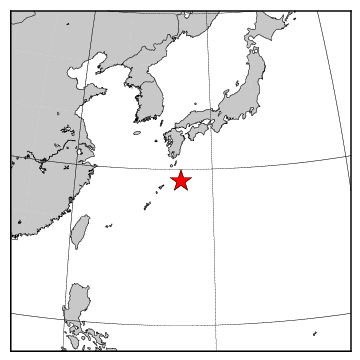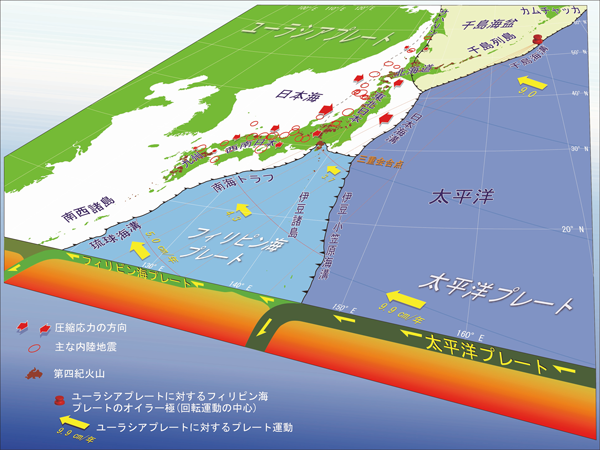キャプティブ 2024.11.20
CA 66 再び動き出したか、南海トラフ
目次
Copyright © Shinichiro Hatani 2024 All rights reserved
For those who prefer to read this column in English, the Japanese text is followed by a British English translation, so please scroll down to the bottom of the Japanese text.
本年、2024年8月、「南海トラフ地震臨時情報」が初めて発表された。その後大きな動きが観測されなかったため、2週間後「南海トラフ地震臨時情報(巨大地震注意)発表に伴う政府としての『特別な注意の呼びかけ』」の終了」が発表され、ホッと胸をなで下ろしたが、3日前、2024年11月17日、奄美大島北東沖でマグニチュード6.0の大地震が発生したとの記述が、気象庁ホームページの「地震情報」に掲載された。
「最大震度は奄美市で『3』」であり、被害も無かったことからメディアが大きく報道することは無かった。「震度」というのは「地震計のハリ」が動くところ、陸地で観測される数値である。
「奄美大島北東沖」は、下記「気象庁のホームページ」より引用した地図で「赤い星印」が記された場所である。この「常に動いている海」の上の「震度」は測りようが無いが、どれほどの大きさであっただろうか。

1.地球を覆う「プレート」の厚さ
この陸地での震度が3程度の「マグニチュード6.0」の地震が気になったのは、「震源の深さ」が10kmというところであった。

この図は、「国立研究開発法人 産業技術総合研究所(「産総研」)」のホームページから、「日本列島周辺のプレート運動と頻発する内陸地震 本州の広い範囲は東西方向に押されている(図中の赤矢印)」と題する図を引用したものである。
ユーラシアプレートや北米プレート等の大陸側プレートの厚さは30~100kmあるが、 海洋側プレートの厚さは5~7km程度で、プレートが接する境界面の深さは10~30 km程度とされている。巨大な地球規模のプレートである、当然その接地面は広く、厚みは数十kmにもなっているが、最初に直接接する面は「海溝・トラフの深さ」、世界で最も深い海溝は、太平洋にあるマリアナ海溝、最深部のチャレンジャー海淵の深さは、約10,920m。つまり海面からの深さが10km程度である。
南海トラフ沿いに発生する可能性のある、東海・東南海・南海地震は、日本で地震の記録が残っている期間、1300年間に9回発生した。南海トラフ地震を引き起こす「想定震源域」とされるのが、フィリピン海プレートが陸側のユーラシアプレートに潜り込んでいる、南海トラフ及び南西諸島の沖縄トラフである。冒頭の11月17日発生したマグニチュード6.0の地震の深さが10kmということから、「プレートの接地面の上部が動いたのでは・・」と懸念を覚えたのである。
2.マグニチュード
本コラムでは、度々「マグニチュード」のことを記してきた。地震の規模・大きさを示す数値は「マグニチュード」であるが、日本の観測史上最大と言われる、2011年3月11日に発生した「東日本大震災」のマグニチュードは9.0であった。
プレートがぶつかりあっている海溝、トラフで発生する地震を「海溝型地震」と呼ぶが、内陸にある断層が動くことによって発生する地震は「断層型地震」と呼ばれている。
この「断層型地震」であった、1995年1月17日に発生した「阪神・淡路大震災」は、甚大な損害を与える地震であったが、そのマグニチュードは7.3であった。
マグニチュードは、数値が1つ増えると、エネルギー量は、単なる「プラス1」ではなく約30倍になる。このため、マグニチュードが2つ違うとその二乗、地震のエネルギー量は約1,000倍となる。マグニチュードが3つ大きくなると地震のエネルギーの差は実に約30,000倍となる。小数点以下、例えばマグニチュード0.1の差でもエネルギー量では約1.4倍の差、マグニチュード0.2の差で約2倍となるのである。
この計算式から、未曾有の被害をもたらした東日本大震災は、マグニチュード9.0の地震であったが、そのエネルギー量は阪神・淡路大震災の実に300倍の巨大地震、如何に「海溝型地震」が巨大なエネルギーを発生させるかが理解できる。

3.地震保険制度
「日本損害保険協会の公式WEBサイト『地震保険』」のページを見ると、地震保険制度について、以下の説明が記されている。
公共性の高い保険
地震保険は、「地震保険に関する法律」に基づき、政府と損害保険会社が共同で運営する公共性の高い保険です。
地震保険では、大地震による巨額の保険金の支払いに備えて政府がバックアップしています。
一方、政府、財務省の公式WEBサイトに記載されている「地震保険制度の概要」には、「政府による再保険」に関して、以下のような詳しい説明が記されている。
「財務省の公式WEBサイト『地震保険制度の概要』」のページ。
政府による再保険
地震等による被災者の生活の安定に寄与することを目的として、民間保険会社が負う地震保険責任を政府が再保険し、再保険料の受入れ、管理・運用のほか、民間のみでは対応できない巨大地震発生の際には、再保険金の支払いを行うために地震再保険特別会計において区分経理しています。
1回の地震等により政府が支払うべき再保険金の総額は、毎年度、国会の議決を経た金額を超えない範囲内のものでなければならないとされています。
現在、その金額は11兆8,083億円であり、民間保険責任額と合計した1回の地震等による保険金の総支払限度額は12兆円です。
総支払限度額は、これまでも関東大震災クラスの地震と同等規模の巨大地震が発生した場合においても対応可能な範囲として決定されています。過去、阪神・淡路大震災や東日本大震災などの巨大地震が発生した際にも、保険金の支払額は総支払限度額内であり、円滑に保険金が支払われております。
なお、万一、この額を超える被害地震が発生したときには、被害の実態に即し、また、被災者生活再建支援制度の活用など他施策も考慮しつつ、保険制度の枠内にとらわれず幅広い観点から、財源の確保も含め、適時適切に政策判断が行われるものと考えております。
4.地震保険制度の限界
つまり、地震保険の対象となる「個人の住居、家財」等に地震保険が掛けられていた場合、「1 回の地震等による損害保険会社全社の支払保険金総額が11.7兆円を超える場合」に「支払われる保険金」は、「全損、大半損、小半損または一部損の算出保険金× 11.7兆円」を「算出保険金総額」で按分した金額になるということである。
これまで大地震、 東日本大震災が発生した際にも、削減することなく保険金は支払われているが、万が一「算出保険金総額」 (=全保険会社が支払う保険金総額)が11.7兆円を越える場合、支払われる保険金の額は、「算出保険金総額」 (=全保険会社が支払う保険金の総額)を分母に置いて分子に11.7兆円を置き、それに「自分に支払われるべき保険金」を乗じたものになる。
南海トラフ地震が発生して、もし最大損害予測値の220兆円の「算出保険金総額」 (=全保険会社が支払う保険金総額)が必要になった場合、「2000万円の保険金額で地震保険を掛けていて、保険金額満額の支払い対象になるような全損が発生した場合」でも、「2000万円×11.7兆円÷220兆円=約107万円の保険金しか支払われない」という計算になってしまうのである。
この意味からも、一般的に「個人の住居、家財」の補償のために提供されている「地震保険」は、「完全復旧を補償するものではない」ものであり、あくまでも「地震被害を受けた際の当座の生活資金を補償するもの」と考えた方が良いものである。それを裏付けるように、「日本損害保険協会の公式WEBサイト」の地震保険の説明ページには次の様な説明が掲載されている。
備えて安心 地震保険の話
概要
地震はいつどこで起こるかわかりません。
そんな地震や噴火、これらによる津波に対して、経済的に備えるのが地震保険です。
このパンフレットでは、被災後の当面の生活を支えてくれる地震保険の内容について、わかりやすく解説しています。
まさに、「当面の生活を支えてくれる地震保険」となっている。
「復旧、しかも完全復旧を補償する保険」を求めるのなら「別の手段」を検討すべきであろう。個人では、大半家屋は数千万円程度の被害額だが、企業となれば数十億円、数百億円もの被害となる。だからこそ、「地震が発生した場合、購入した保険条件で、地震保険を満額得られる手段」としてキャプティブが注目されている、その大きな理由がここにある。

5.企業用「地震保険」
「企業用火災保険に地震危険補償特約を付帯して引受」するものが「企業用地震保険」となる。ただ、この企業用「地震保険」でも、個人の「地震保険」と同様、一般的には「財物損壊のみ」を補償するものとして、設計、提供されている。
建物、収納されている機械類が損害を受けることによって、地震以前と同等に事業を継続することが困難になった場合、事業収益の低下をきたすが、この「事業中断(=収益の低下)」を補償する補償が提供されることは、限定的であり一般的ではない。
その理由としては、①「収益低下への補償は、損害保険会社の特約再保険では、一般的には対象外になっているため、再保険会社と一から個別に交渉しなければならず、補償枠を得られる可能性も高くない」ため、また、②そもそも、「限りある地震保険の引受けキャパシティ(引受枠)をより多くの顧客に販売するため」である。
しかし、欧米で提供されている、世界レベルの地震保険は、一般的に「財物損壊」の補償と「事業中断(=収益の低下)」への補償を併せ持ったものであり、日本では一般的には得られない補償内容である。
前述のとおり、「補償額の面」でキャプティブが注目を浴びているが、実はこの「補償範囲」の点でもキャプティブの有用性が際立っているのである。
つまり、キャプティブは再保険の仕組みによって、「世界レベルの『財物損壊』の補償と『事業中断(=収益の低下)』への補償を併せ持った地震保険を得ることができるプログラム」だからである。
そして、このコラムを投稿しようとしている本日、気象庁の上記「地震情報」には「11月20日午前3時36分」地震発生、宮城県、福島県、茨城県、栃木県、千葉県、東京都、神奈川県で、最大震度2を観測するマグニチュード5.0の地震が発生との記述があり、震源地は「駿河湾南方沖で、震源の深さはおよそ250km」、上述の「 産業技術総合研究所(「産総研」)」の「日本列島周辺のプレート運動と頻発する内陸地震 本州の広い範囲は東西方向に押されている(図中の赤矢印)」という図を見ると、その震源地は南海トラフの最西端周辺であることが分かる。
今回のまとめ
地震国日本である。南海トラフ地震のような海溝型地震だけでなく、断層型の大地震が起きる可能性は大いにある。
政府の地震調査研究推進本部(地震本部)によると、「活断層と定義されているものは日本列島には約2000」、このうち「大きな被害をもたらすと考えられている主要な活断層は114ある」が、「30年以内の地震発生確率が高い活断層帯は全国で30カ所を超える」からである。
「地震保険の引受キャパシティ(引受力)を海外の再保険会社の力によって補完できる」のがキャプティブである。地震保険の「補償額」及び「補償範囲」、この両面で、残念ながら「頼りない地震保険制度」を補完することができる存在はキャプティブを於いて他にはないと言える。
「地震リスクが怖いが、地震保険料が高い」とこれまで地震保険を掛けてこなかった企業は、地震リスクへの強力なプロテクションとしてキャプティブに真剣に取り組む時期ではないだろうか。
執筆・翻訳者:羽谷 信一郎
English Translation
Captive (CA) 66 – Has the Nankai Trough started moving again?
This year, in August 2024, the ‘Nankai Trough Earthquake Special Information’ was announced for the first time.
As no major movements were observed after that, two weeks later the end of the ‘Nankai Trough Earthquake Special Information (Warning of a Major Earthquake) Announcement and the Government’s “Call for Special Attention”’ was announced, and we breathed a sigh of relief, but three days ago, the description ‘On 17 November 2024, a magnitude 6.0 earthquake occurred off the northeast coast of Amami Oshima’ appeared on the ‘Earthquake Information’ page of the Japan Meteorological Agency’s website.
The maximum seismic intensity was 3 in Amami City, and as there was no damage, the media did not report it extensively. Seismic intensity is the numerical value observed on land where the ‘seismometer needle’ moves.
The ‘Northeast off Amami Oshima Island’ is the location marked with a red star on the map below, which is taken from the Japan Meteorological Agency website. It is impossible to measure the intensity of an earthquake on this ‘ever-moving sea’, but just how big was it?

1. The thickness of the ‘plates’ that cover the earth
What made me curious about this earthquake with a magnitude of 6.0 and an intensity of 3 on the Japanese scale was the fact that the ‘hypocentre depth’ was 10km.

This diagram is taken from the website of the National Institute of Advanced Industrial Science and Technology (AIST) and is titled ‘Plate Motions around the Japanese Islands and Frequent Inland Earthquakes: Large areas of Honshu are being pushed in an east-west direction (red arrows in the diagram)’.
The thickness of continental plates such as the Eurasian and North American plates is 30 to 100 km, but the thickness of oceanic plates is around 5 to 7 km, and the depth of the boundary surface where the plates meet is thought to be around 10 to 30 km. The surface where the huge global plates meet is naturally very wide, and the thickness of the contact surface is tens of kilometres, but the first surface that directly touches can be thought of as being about the same as the ‘depth of the trench’. The deepest trench in the world is the Mariana Trench in the Pacific Ocean, and the depth of the deepest part, the Challenger Deep, is about 10,920m. In other words, it is around 10km below sea level.
The Tokai, Tonankai and Nankai earthquakes that could occur along the Nankai Trough ‘have occurred nine times in the 1,300 years for which records of earthquakes in Japan have been kept’. The ‘hypocentral region’ that is thought to cause Nankai Trough earthquakes is the Nankai Trough and Okinawa Trough in the Nansei Islands, where the Philippine Sea Plate is subducting under the Eurasian Plate on the landward side. The fact that the earthquake that occurred on 17 November had a magnitude of 6.0 and a depth of 10km led to concerns that the upper part of the plate’s subduction zone may have moved.
The thickness of continental plates such as the Eurasian and North American plates is 30 to 100 km, but the thickness of oceanic plates is around 5 to 7 km, and the depth of the boundary surface where the plates meet is thought to be around 10 to 30 km. The surface where the huge global plates meet is naturally very wide, and the thickness of the contact surface is tens of kilometres, but the first surface that directly touches can be thought of as being about the same as the ‘depth of the trench’. The deepest trench in the world is the Mariana Trench in the Pacific Ocean, and the depth of the deepest part, the Challenger Deep, is about 10,920m. In other words, it is 10km below sea level.
The Tokai, Tonankai and Nankai earthquakes that could occur along the Nankai Trough ‘have occurred nine times in the 1,300 years for which records of earthquakes in Japan have been kept’. The ‘hypocentral region’ that is thought to cause Nankai Trough earthquakes is the Nankai Trough and Okinawa Trough in the Nansei Islands, where the Philippine Sea Plate is subducting under the Eurasian Plate on the landward side. The fact that the earthquake that occurred on 17 November had a magnitude of 6.0 and a depth of 10km led to concerns that the upper part of the plate’s subduction zone may have moved.
2. Magnitude
In this column, I have often written about the concept of magnitude. The magnitude is a numerical value that indicates the scale and size of an earthquake, and the magnitude of the Great East Japan Earthquake, which occurred on 11 March 2011 and is said to be the largest earthquake in recorded history, was 9.0.
Earthquakes that occur in trenches and troughs where tectonic plates collide are called ‘trench-type earthquakes’, while earthquakes that occur when inland faults move are called ‘fault-type earthquakes’.
The Hanshin-Awaji Earthquake that occurred on 17 January 1995 was a ‘fault-type earthquake’ that caused enormous damage, but it had a magnitude of 7.3.
When the magnitude increases by one, the amount of energy does not simply increase by ‘one plus one’, but increases by around 30 times. For this reason, if the magnitude differs by two, the energy of the earthquake will increase by a factor of around 1,000. If the magnitude increases by three, the difference in energy between the two earthquakes will be a factor of around 30,000. Even a difference of 0.1 in magnitude, for example, will result in a difference of around 1.4 in energy, and a difference of 0.2 in magnitude will result in a difference of around 2.
The Great East Japan Earthquake, which caused unprecedented damage, was a magnitude 9.0 earthquake, and this calculation formula shows that the amount of energy it released was a massive 300 times greater than the Great Hanshin-Awaji Earthquake. This shows just how much energy a ‘trench-type earthquake’ can generate.
3. Earthquake Insurance System
If you look at the ‘Earthquake Insurance’ page on the official website of the General Insurance Association of Japan, you will find the following explanation of the earthquake insurance system.
Highly public insurance
Earthquake insurance is a highly public insurance system jointly operated by the government and non-life insurance companies based on the ‘Earthquake Insurance Act’.
The government provides backup for earthquake insurance in preparation for the payment of large insurance claims due to major earthquakes.
On the other hand, the ‘Outline of the Earthquake Insurance System’ on the official website of the government and the Ministry of Finance includes the following detailed explanation of ‘reinsurance by the government’.
‘Outline of the Earthquake Insurance System’ on the official website of the Ministry of Finance.
Government Reinsurance
With the aim of contributing to the stability of the lives of victims of earthquakes and other disasters, the government reinsures the earthquake insurance liability borne by private insurance companies, and in addition to receiving, managing and investing reinsurance premiums, it also carries out separate accounting in the Earthquake Reinsurance Special Account for the purpose of paying reinsurance money in the event of a major earthquake that cannot be dealt with by the private sector alone.
The total amount of reinsurance payments that the government must make following an earthquake or other disaster must not exceed the amount decided by the Diet each year.
Currently, this amount is 11.8083 trillion yen, and the total maximum amount of insurance payments following an earthquake or other disaster, when combined with the amount of private insurance liability, is 12 trillion yen.
The total payment limit has been set as a figure that can cope with even a huge earthquake of the same scale as the Great Kanto Earthquake. In the past, when huge earthquakes such as the Great Hanshin-Awaji Earthquake and the Great East Japan Earthquake occurred, the amount of insurance paid was within the total payment limit, and insurance payments were made smoothly.
In the event that an earthquake with damage exceeding this amount were to occur, we believe that appropriate policy decisions would be made in a timely manner, from a broad perspective that is not limited to the insurance system, including the securing of financial resources, in line with the actual damage and while also taking into account other measures such as the use of the Disaster Victim Life Reconstruction Support System.
4. The limitations of the earthquake insurance system
In other words, if earthquake insurance is taken out on ‘private residences, household goods, etc.’ that are covered by earthquake insurance, and ‘the total amount of insurance paid by all insurance companies for damage caused by a single earthquake exceeds 11.7 trillion yen the amount of insurance paid will be the amount obtained by dividing the ‘total amount of calculated insurance payments’ by ‘the total amount of calculated insurance payments for total loss, major loss, minor loss or partial loss x 11.7 trillion yen’.
In the past, insurance claims have been paid without reduction even in the event of major earthquakes and the Great East Japan Earthquake, but in the unlikely event that the ‘total calculated insurance amount’ (= total insurance amount paid by all insurance companies) exceeds 11.7 trillion yen, the amount of insurance paid would be calculated by taking the ‘total calculated insurance amount’ (= the total amount of insurance paid by all insurance companies) as the denominator, placing 11.7 trillion yen in the numerator, and then multiplying this by the ‘insurance amount payable to you’.
If the Nankai Trough earthquake were to occur and the maximum damage estimate of 220 trillion yen in ‘total calculated insurance payouts’ (= total insurance payouts from all insurance companies) were required, even if ‘a total loss occurs that is covered by the full amount of the insurance payout, with earthquake insurance taken out for an insurance amount of 20 million yen even if a total loss occurs that would be eligible for the full amount of the insurance payout, the calculation would be 20 million yen x 11.7 trillion yen ÷ 220 trillion yen = approximately 1.07 million yen in insurance payout.
From this point of view, earthquake insurance, which is generally provided to cover ‘personal residences and household goods’, does not ‘cover full restoration’, and is only ‘designed to cover living expenses in the event of earthquake damage’. To support this, the following explanation is given on the earthquake insurance explanation page of the official website of the General Insurance Association of Japan.
Earthquake Insurance: Be prepared and rest assured
Overview
You never know when or where an earthquake will strike.
Earthquake insurance is a way of financially preparing for earthquakes, volcanic eruptions and the resulting tsunamis.
This pamphlet provides a simple explanation of the contents of earthquake insurance that will support your immediate lifestyle after a disaster.
It says ‘earthquake insurance that will support your immediate lifestyle’.
If you are looking for ‘insurance that covers restoration and complete restoration’, you should consider ‘other options. For individuals, the damage to most houses is in the tens of millions of yen, but for companies, the damage can be in the tens or hundreds of billions of yen. This is why captives are attracting attention as a way of obtaining full earthquake insurance coverage under the terms of the insurance policy purchased in the event of an earthquake, and this is the main reason for this.
5. Earthquake insurance for businesses
‘Earthquake insurance for businesses’ is taken out by attaching an earthquake risk compensation special clause to a fire insurance policy for businesses. However, as with personal earthquake insurance, this type of earthquake insurance for businesses is generally designed and provided as a policy that only covers property damage.
If a business becomes unable to continue as before due to damage to buildings or stored machinery, this will result in a decline in business revenue, but compensation for this ‘interruption of business (i.e. decline in revenue)’ is limited and not common.
The reasons for this are (i) ‘because compensation for reduced earnings is generally not covered by special reinsurance policies from non-life insurance companies, it is necessary to negotiate with reinsurance companies from scratch, and the possibility of obtaining compensation is not high’, and (ii) ‘in the first place, in order to sell the limited earthquake insurance underwriting capacity (underwriting limit) to more clients’.
However, the world-class earthquake insurance policies offered in Europe and the US generally provide both property damage coverage and business interruption (i.e. loss of earnings) coverage, which is not generally available in Japan.
As mentioned above, captives are attracting attention in terms of the amount of compensation they provide, but in fact, their usefulness is also particularly evident in terms of the scope of their coverage.
In other words, captives are a programme that enables you to obtain ‘earthquake insurance that combines world-class property damage coverage with business interruption (i.e. revenue decline) coverage’ through a reinsurance mechanism.
And today, as I am writing this column, the Japan Meteorological Agency’s ‘Earthquake Information’ states that ‘at 3:36am on 20th November, an earthquake of magnitude 5.0 occurred, with a maximum seismic intensity of 2 observed in Miyagi, Fukushima, Ibaraki, Tochigi, Chiba, Tokyo and Kanagawa prefectures. The epicentre was ’in the southern part of the Suruga the southern part of Suruga Bay, with a depth of around 250km’. Looking at the above-mentioned figure from the National Institute of Advanced Industrial Science and Technology (AIST), “Plate Motions around the Japanese Islands and Frequent Inland Earthquakes – Large areas of Honshu are being pushed in an east-west direction (red arrow in the figure)”, it can be seen that the epicentre is around the westernmost part of the Nankai Trough.
Summary of this issue
Japan is an earthquake-prone country. There is a great possibility that not only trench-type earthquakes such as the Nankai Trough Earthquake, but also major fault-type earthquakes will occur. According to the Headquarters for Earthquake Research Promotion (Earthquake Headquarters) of the Japanese government, ‘there are around 2000 active faults in the Japanese archipelago’, of which ‘114 are major active faults that are thought to cause significant damage’, and ‘there are over 30 active fault zones across the country where the probability of an earthquake occurring within 30 years is high’.
Captives are able to supplement the underwriting capacity (ability to accept insurance) of earthquake insurance through the power of overseas reinsurance companies. In terms of both the ‘amount of compensation’ and the ‘scope of coverage’ of earthquake insurance, it can be said that captives are the only ones that can supplement the ‘unreliable earthquake insurance system’.
For companies that have not taken out earthquake insurance in the past because they are afraid of earthquake risk but find the cost of earthquake insurance too high, perhaps it is time to seriously consider a captive as a powerful form of protection against earthquake risk.
Author/translator: Shinichiro Hatani

